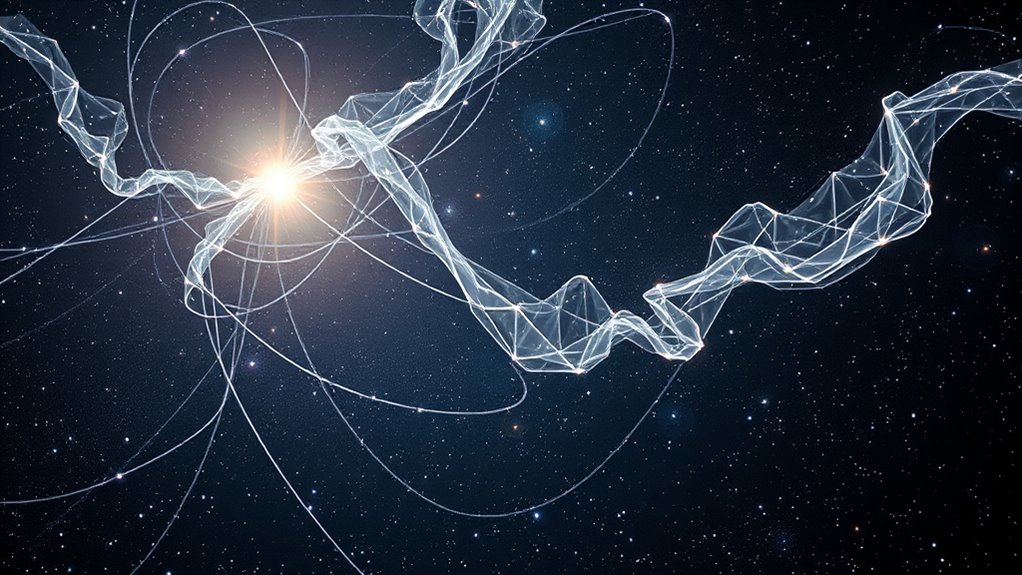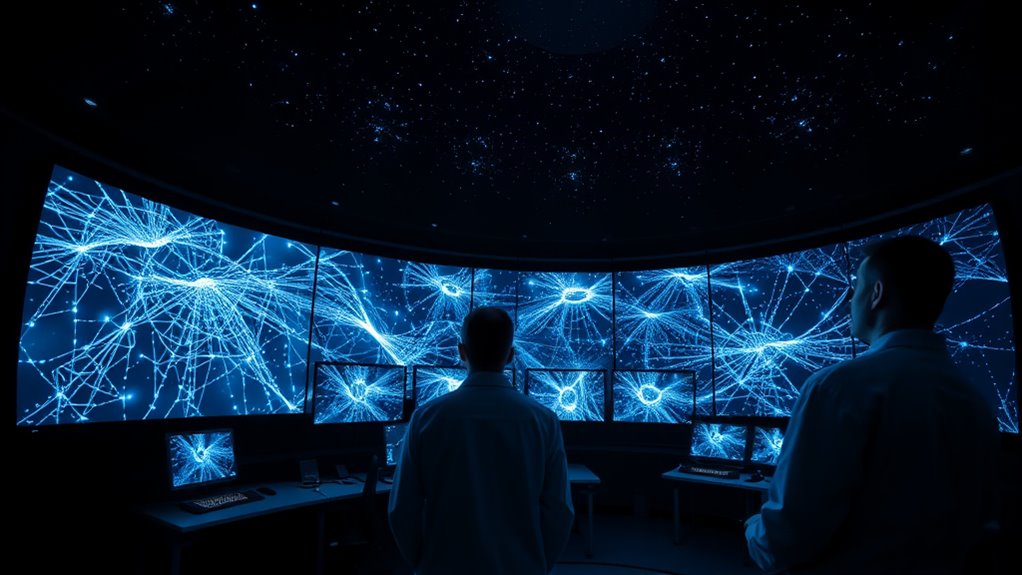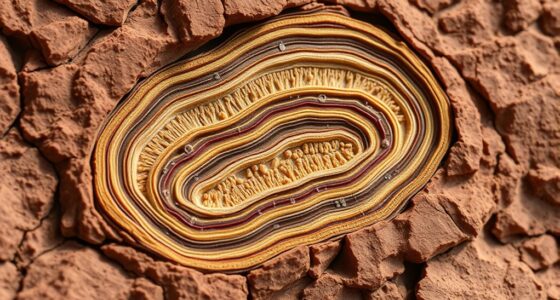Scientists have created the most detailed 3D map of dark matter, revealing its vast web-like structure across the universe. This map uses gravitational effects to detect invisible matter and shows how dark matter forms filaments, clusters, and voids that shape cosmic evolution. It confirms dark matter’s vital role in galaxy formation and large-scale patterns. If you want to explore how this discovery deepens our understanding of the universe, keep going.
Key Takeaways
- Researchers developed the most detailed 3D dark matter map, revealing its complex cosmic web structure.
- The map uses gravitational lensing to detect invisible dark matter across vast regions of the universe.
- Findings confirm dark matter’s critical role in shaping galaxy formation and large-scale cosmic patterns.
- Advanced techniques improve understanding of the universe’s composition and help refine cosmological models.
- This breakthrough deepens insights into dark matter’s influence on cosmic evolution and future universe development.

Scientists have developed the most extensive 3D map of dark matter to date, offering new insights into the universe’s hidden structure. This breakthrough allows you to see how dark matter is spread across vast cosmic scales, revealing patterns that shape the cosmos. Unlike visible matter, dark matter doesn’t emit, absorb, or reflect light, making it invisible to traditional telescopes. Instead, scientists rely on gravitational effects to understand its distribution. By mapping these effects in three dimensions, you can now better grasp how dark matter influences the large-scale structure of the universe.
This detailed map shows that dark matter isn’t randomly scattered but forms a complex web-like network called the cosmic web. You’ll notice filaments, clusters, and voids—regions densely packed with dark matter surrounded by expansive empty spaces. This distribution plays a critical role in cosmic structure formation. Dark matter acts as the gravitational backbone around which ordinary matter clumps together, leading to galaxy formation. As you examine the map, you see that galaxies tend to reside within these dense dark matter halos, highlighting the deep connection between dark matter distribution and galaxy evolution.
Dark matter forms a cosmic web of filaments, clusters, and voids shaping galaxy formation and evolution.
The insights from this map deepen your understanding of how the universe evolved. In the early universe, tiny fluctuations in dark matter density served as the seeds for all subsequent structure. Over billions of years, gravity pulled matter into these fluctuations, forming the cosmic web you now observe. The map confirms that dark matter’s influence extends far beyond individual galaxies, shaping the large-scale patterns that define the universe’s architecture. It helps you visualize how the initial dark matter distribution influenced the cosmic structure formation process, guiding the growth of galaxies, clusters, and superclusters. Additionally, advancements in gravitational lensing techniques have been crucial for detecting and mapping dark matter with greater precision.
Furthermore, this map challenges and refines existing models of cosmology. You realize that understanding the precise distribution of dark matter helps in testing theories about the universe’s composition and evolution. The data suggests that dark matter’s role is even more significant than previously thought, affecting everything from galaxy rotation curves to the expansion rate of the universe. By revealing the detailed structure of dark matter, you gain a clearer picture of the universe’s past, present, and future. Recognizing the cosmic web structure is essential for understanding the universe’s evolution and the role dark matter plays in shaping it.
Frequently Asked Questions
How Does Dark Matter Influence Galaxy Formation?
You might wonder how dark matter influences galaxy formation. Dark matter interactions create gravitational wells that attract normal matter, guiding galaxy evolution. Without dark matter, galaxies wouldn’t have the necessary mass to form or stay intact. Its invisible presence shapes the large-scale structure of the universe, affecting how galaxies grow and merge over time. So, dark matter plays a crucial role in shaping the universe’s cosmic architecture.
Can Dark Matter Be Detected Directly?
You can’t detect dark matter directly yet because its particle properties make it elusive. Scientists conduct direct detection experiments by looking for rare interactions between dark matter particles and regular matter. These experiments aim to observe faint signals that reveal dark matter’s presence. Although we haven’t succeeded so far, ongoing research keeps improving detection methods, bringing us closer to understanding this mysterious substance’s true nature.
What Are the Challenges in Mapping Dark Matter?
You’d think mapping dark matter would be straightforward, but irony is, it’s incredibly challenging. You can’t detect dark matter directly, so scientists rely on gravitational lensing to infer its presence. The challenge lies in accurately measuring subtle distortions in light from distant galaxies. These tiny signals demand precise observations and complex data analysis, making the task as tricky as chasing shadows in the dark—literally.
How Does This Map Compare to Previous Models?
This new map offers a more detailed view of dark matter distribution than previous models, thanks to advanced mapping techniques. You can see finer structures and better understand how dark matter interacts with visible matter. Unlike earlier maps, which had limited resolution, this one reveals the universe’s large-scale structure more clearly. You get a deeper insight into cosmic evolution, helping to solve the mystery of dark matter’s role in shaping the cosmos.
What Future Research Is Enabled by This Map?
Imagine gazing into a cosmic labyrinth where every twist reveals hidden secrets. This map opens new doors for your research, allowing you to refine dark matter simulations and better understand cosmic structure. With this detailed blueprint, you can test theories, explore dark matter’s role in galaxy formation, and predict unseen phenomena. It’s your key to exploring the universe’s dark corridors, pushing the boundaries of knowledge and discovery.
Conclusion
You now see how scientists gently illuminate the universe’s hidden threads, revealing a delicate web that weaves through the cosmos. This vast map hints at mysteries still waiting to be unraveled, like shadows dancing in the twilight. As you ponder these silent markers of the universe, remember that each discovery softly guides us closer to understanding the grand cosmic puzzle, inspiring hope that someday, the secrets of the dark will open like a gentle dawn.









